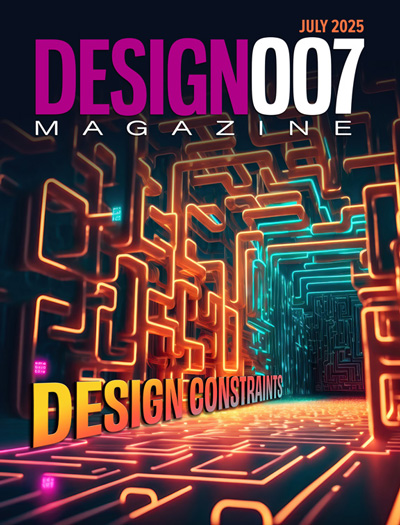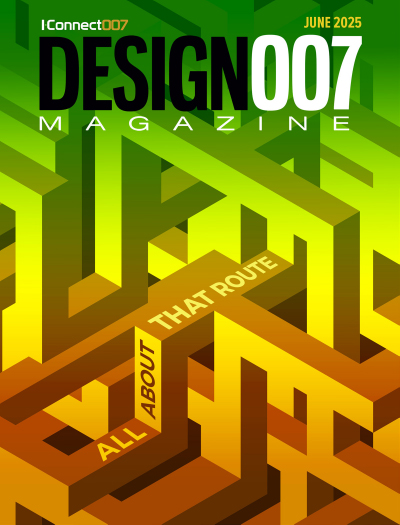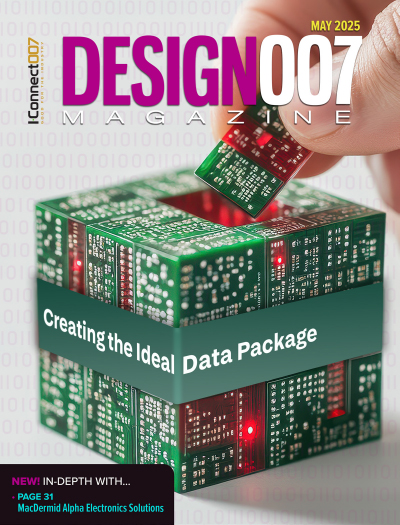-

- News
- Books
Featured Books
- design007 Magazine
Latest Issues
Current Issue
Showing Some Constraint
A strong design constraint strategy carefully balances a wide range of electrical and manufacturing trade-offs. This month, we explore the key requirements, common challenges, and best practices behind building an effective constraint strategy.

All About That Route
Most designers favor manual routing, but today's interactive autorouters may be changing designers' minds by allowing users more direct control. In this issue, our expert contributors discuss a variety of manual and autorouting strategies.

Creating the Ideal Data Package
Why is it so difficult to create the ideal data package? Many of these simple errors can be alleviated by paying attention to detail—and knowing what issues to look out for. So, this month, our experts weigh in on the best practices for creating the ideal design data package for your design.
- Articles
- Columns
- Links
- Media kit
||| MENU - design007 Magazine
IPC Designers Council Viewpoint: Rick Hartley
December 30, 2015 | Andy Shaughnessy, PCBDesign007Estimated reading time: 2 minutes
Rick Hartley has been in involved in PCB design and design education for decades, so it’s no surprise that he started working with the IPC Designers Council early on. Now retired from his day job at L-3, Rick still teaches PCB design and shows no sign of slowing down. I asked him to discuss his work with the Designers Council, and what the group means to the design community.
Andy Shaughnessy: How and when did you get involved in the Designers Council?
Rick Hartley: I first learned about Designers Council at an IPC conference in the early 1990s. Shortly afterward, I was contacted by another central Ohio designer, Candice Antrett, of Battelle Research Institute. Candice was also interested in the DC and suggested we collectively start a chapter. Pete Waddell had Printed Circuit Design magazine do a mailing for us to help get the word out, and we have always been grateful for that generous act. We held our first meeting at Battelle, and were off and running. Our membership area was mainly Columbus, Dayton and Cincinnati.
Shaughnessy: What are the some of the most important benefits that the Designers Council offers designers, and the industry?
Hartley: For those chapters that are still going strong, the benefits are massive. There is NO formal education in PCB design. For the most part, colleges do not teach the profession. Some colleges barely even mention the existence of PC boards, much less tell their students anything meaningful. IPC and the active DC chapters are doing a wonderful job of training the industry about the many issues we need to understand; I don’t mean just designing to make boards function, but incredibly important issues like DFX (i.e., design for fabrication, design for assembly and design for testability). For people who do not live in the area of an active chapter, there is the IPC APEX EXPO conference and other wonderful educational resources, such as PCB West Design Conference and online webinars from multiple sources, including IPC.
Shaughnessy: What's exciting about the DC today?
Hartley: All the items mentioned earlier. And, of course, there is the CID (Certified Interconnect Designer) and CID+ (Advanced) training and certification. This can be a very valuable asset to designers and EEs. One of the greatest benefits I derived from chapter membership was networking. I could write a book on the value of networking with others in your profession. Those folks lucky enough to still have a local chapter and those who network at conferences know exactly what I mean.
To read this entire article, which appeared in the December 2015 issue of The PCB Design Magazine, click here.
Testimonial
"In a year when every marketing dollar mattered, I chose to keep I-Connect007 in our 2025 plan. Their commitment to high-quality, insightful content aligns with Koh Young’s values and helps readers navigate a changing industry. "
Brent Fischthal - Koh YoungSuggested Items
Target Condition: The 5 Ws of PCB Design Constraints
07/29/2025 | Kelly Dack -- Column: Target ConditionHave you ever sat down to define PCB design constraints and found yourself staring at a settings window with more checkboxes than a tax form? You’re not alone. For many designers—especially those newer to the layout world—the task of setting up design constraints can feel like trying to write a novel in a language you just started learning.
Zuken to Showcase Defence & Security-Focused Electronic Systems Design Solutions at DSEI 2025
07/24/2025 | ZukenZuken, a global leader in electronic and electrical design automation, will showcase its latest innovations for defence and security systems at DSEI 2025, taking place at ExCeL London from 9–12 September 2025.
Creating a Design Constraint Strategy
07/24/2025 | I-Connect007 Editorial TeamMost designers learn how to set their design constraints through trial and error. EDA vendors’ guidelines explain how to use their particular tools’ constraints, and IPC standards offer a roadmap, but PCB designers usually develop their own unique styles for setting constraints. Is there a set of best practices for setting constraints? That’s what I asked Global Electronics Association design instructor Kris Moyer, who covers design constraints in his classes.
Elementary Mr. Watson: Closing the Gap Between Design and Manufacturing
07/23/2025 | John Watson -- Column: Elementary, Mr. WatsonModern PCB designers are not merely engineers or technicians. I believe that PCB design, at its core, is an art form, and modern PCB designers should be considered artists. Beyond the technical calculations and engineering rules lies a creative process that involves vision, balance, and a passion for what we do. Like any artist who works with brush and canvas or chisel and stone, a PCB designer shapes invisible pathways that bring ideas to life. Each trace, layer, and component placement reflects thoughtful decisions that blend form, fit, and function.
Designers Notebook: Basic PCB Planning Criteria—Establishing Design Constraints
07/22/2025 | Vern Solberg -- Column: Designer's NotebookPrinted circuit board development flows more smoothly when all critical issues are predefined and understood from the start. As a basic planning strategy, the designer must first consider the product performance criteria, then determine the specific industry standards or specifications that the product must meet. Planning also includes a review of all significant issues that may affect the product’s manufacture, performance, reliability, overall quality, and safety.


